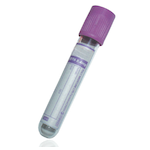Suitable Specimen Types
- EDTA Plasma
Specimen Transport
Transport to Referral Laboratory frozenSample Processing in Laboratory
Please transport to BHH as soon as possible, plasma must be separated within 15 mins of venepuncture.Sample Preparation
Plasma must be separated within 15 mins of taking and freeze immediately.Turnaround Time
10 working daysSample Stability
- 20 ºCOxalate
General Information
Oxalate is a dicarboxylic acid, which is an end-product of liver metabolism of glyoxalate and glycerate. Humans have no enzyme capable of degrading oxalate, which is quite insoluble, particularly when precipitated with calcium. Oxalate is important primarily because it affects kidney stone formation. About 85% of all kidney stones contain calcium oxalate in some proportion. Oxalate also may precipitate in tissues, causing tissue toxicity.In the absence of disease, up to 90% of the body pool of oxalate is produced by hepatic metabolism and the other 10% is provided by the oxalate in food. However, in the presence of gastrointestinal disease, the percentage absorbed from food can be much greater.
Oxalate is filtered by the glomerulus and efficiently secreted by the renal tubules. Once the glomerular filtration rate (GFR) begins to decrease, the pool size increases, but plasma levels do not increase out of the normal range until the GFR decreases to <10 mL/min to 20 mL/min. Plasma oxalate concentration is a reflection of the body pool size. When the pool increases, oxalate may precipitate in tissues and cause toxicity. Plasma oxalate pool size can be increased in various situations:
- Increased production and accumulation results from an abnormality in at least 2 different enzymes. Alanine glyoxalate transferase is necessary for the conversion of glycolate to alanine. A deficiency or intracellular mistargeting of this hepatic enzyme results in increased oxalate production (primary hyperoxaluria I). Hepatic glycolate reductase/hydroxypyruvate reductase deficiency results in increased glyceric acid formation, which eventually leads to increased oxalate production (primary hyperoxaluria II).
- Pool size of oxalate can be increased by increased absorption from the intestine after consuming foods such as rhubarb, nuts, chocolate, or tea.
- Certain abnormalities of the gastrointestinal tract, including fat malabsorption, short bowel syndromes, and abnormal bile salt metabolism, all result in increased oxalate absorption from the intestinal tract.
- Increased pool size can result from decreased urinary excretion as occurs in chronic renal insufficiency
Primary hyperoxaluria is typically diagnosed by measuring oxalate levels in urine. However, as kidney function decreases, the renal excretion of oxalate also decreases. In such situations, plasma oxalate levels may be informative. Plasma oxalate is often used to monitor these patients during critical periods in and around kidney transplantation, dialysis, or liver transplantation.
High values are suggestive of primary hyperoxaluria. However if the patient has chronic kidney disease (GFR <30ml/min/1.732m2) plasma oxalate can be normal.
Patient Preparation
NoneNotes
Plasma oxalate always increased in renal failure. If renal function normal, urine oxalate is preferred test.Reference Range
Provided by Reference LaboratorySpecifications
- EQA Status: No details
